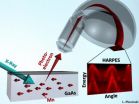(Press-News.org) 'Direct to consumer' research, using data obtained through increasingly popular online communities such as 23andMe, PatientsLikeMe and the Personal Genome Project, has methodological limitations that are known to epidemiological studies, including selection bias, information bias, and confounding. These limitations mean that the results and conclusions of research using these methods need to be interpreted with caution, according to a paper published in the journal PLoS Medicine.
Cecile Janssens, PhD, formerly of the Erasmus University Medical Center in The Netherlands and currently research professor of epidemiology in the Rollins School of Public Health, Emory University, and Peter Kraft, PhD, from the Harvard School of Public Health, argue that the findings of 'direct to consumer' research should be communicated in a way that is understandable, accurate, complete and not misleading. Researchers do often address methodological limitations in their scientific publications, but not on their websites, say the authors.
Studies relying on collections of self-reported data by self-selected participants raise critical questions that require further ethical analysis and public debate – for example, regarding the provision of adequate consent, the safeguarding of public trust, disclosure of commercial development of research results, and the sale of participants' data to third parties.
"We worry that overstating the conclusions that can be drawn from these resources may impinge on individual autonomy and informed consent," the authors say. "Only a responsible approach with realistic expectations about what can be done with and concluded from the data will benefit science in the long run."
The authors argue that clarity regarding the benefits of research using solicited personal data is particularly important when the data collected are also used for other purposes, such as selling participants' information to pharmaceutical and insurance companies.
"The potential for sharing participants' data with third parties as well as the commercial uses of research findings should be disclosed more explicitly to participants prior to consent," they conclude.
###
After embargo, the paper will be available at the following link:
http://www.plosmedicine.org/article/info%3Adoi%2F10.1371%2Fjournal.pmed.1001328
Limitations to the 'revolutionary' findings of online studies
2012-10-24
ELSE PRESS RELEASES FROM THIS DATE:
Study: Amish children are 2 times more physically active than non-Amish children
2012-10-24
BALTIMORE, Md. – Oct. 23, 2012. Old Order Amish children are much more physically active and three times less likely to be overweight than non-Amish children, which may provide them with some long-term protection against developing Type 2 diabetes, University of Maryland School of Medicine researchers report in the journal Diabetes Care.
The researchers found that Amish children in Lancaster County, Pa., spent an additional 34 minutes a day in light physical activity, plus another 53 additional minutes a day in moderate to vigorous activity compared to non-Amish white ...
Neuroscientists propose revolutionary DNA-based approach to map wiring of whole brain
2012-10-24
Cold Spring Harbor, NY -- A team of neuroscientists has proposed a new and potentially revolutionary way of obtaining a neuronal connectivity map (the "connectome") of the whole brain of the mouse. The details are set forth in an essay published October 23 in the open-access journal PLOS Biology.
The team, led by Professor Anthony Zador, Ph.D., of Cold Spring Harbor Laboratory, aims to provide a comprehensive account of neural connectivity. At present the only method for obtaining this information with high precision relies on examining individual cell-to-cell contacts ...
Twitter principles of social networking increase family success in nesting birds
2012-10-24
New research carried out by scientists at Universities in Exeter, France and Switzerland reveals for the first time the importance of social networking in producing a successful family.
The study found that, regardless of how big and healthy individual chicks are, what really matters to their chances of surviving and breeding is how siblings in the nest interact with each other, with cooperative families faring best.
Differences in patterns of feeding between mothers and fathers were a key factor in determining the behaviour of their offspring, according to the study ...
Summer babies less likely to be CEOs: UBC research
2012-10-24
Sauder School of Business researchers at the University of British Columbia have found that a person's date of birth can affect their climb up the corporate ladder.
The Sauder study shows that only 6.13 per cent of an S&P 500 CEO sample was born in June and only 5.87 per cent of the sample was born in July. By comparison, people born in March and April represented 12.53 per cent and 10.67 per cent of the sample of CEOs.
"Our findings indicate that summer babies underperform in the ranks of CEOs as a result of the 'birth-date effect,' a phenomenon resulting from the ...
Blood chromosome differences are linked to pancreatic cancer
2012-10-24
MADISON – A new study shows that a blood marker is linked to pancreatic cancer, according to a study published today by scientists at the University of Wisconsin Carbone Cancer Center and Mayo Clinic.
First author Dr. Halcyon Skinner, assistant professor of population health sciences at the University of Wisconsin School of Medicine and Public Health, says the study is the first time pancreatic cancer risk has been linked to differences in telomeres' length in blood cells.
"This suggests a new avenue to identify those with pancreatic cancer or those at risk of developing ...
Genetic patterns of deep-sea coral provide insights into evolution of marine life
2012-10-24
The ability of deep-sea corals to harbor a broad array of marine life, including commercially important fish species, make these habitat-forming organisms of immediate interest to conservationists, managers, and scientists. Understanding and protecting corals requires knowledge of the historical processes that have shaped their biodiversity and biogeography.
While little is known about these processes, new research described in the journal Molecular Ecology helps elucidate the historical patterns of deep-sea coral migration and gene flow, coincident with oceanic circulation ...
New finding could pave way to faster, smaller electronics
2012-10-24
University of California, Davis, researchers for the first time have looked inside gallium manganese arsenide, a type of material known as a "dilute magnetic semiconductor" that could open up an entirely new class of faster, smaller devices based on an emerging field known as "spintronics."
Materials of this type might be used to read and write digital information not by using the electron's charge, as is the case with today's electronic devices, but by using its "spin."
Understanding the magnetic behavior of atoms is key to designing spintronics materials that could ...
New paper examines shifting gears in the circadian clock of the heart
2012-10-24
A new study conducted by a team of scientists led by Giles Duffield, assistant professor of biological sciences and a member of the Eck Institute for Global Health at the University of Notre Dame focuses on the circadian clock of the heart, and used cultured heart tissue. The results of the new study have implications for cardiovascular health, including daily changes in responses to stress and the effect of long-term rotational shift work.
Previous studies by a research group at the University of Geneva demonstrated a role for glucocorticoids in shifting the biological ...
Droplet response to electric voltage in solids exposed
2012-10-24
DURHAM, N.C. – For the first time, scientists have observed how droplets within solids deform and burst under high electric voltages.
This is important, the Duke University engineers who made the observations said, because it explains a major reason why such materials as insulation for electrical power lines eventually fail and cause blackouts. This observation not only helps scientists develop better insulation materials, but could also lead to such positive developments as "tunable" lenses for eyes.
As the voltage increases, water droplets, or air bubbles, within ...
Analysis of dinosaur bone cells confirms ancient protein preservation
2012-10-24
A team of researchers from North Carolina State University and the Palo Alto Research Center (PARC) has found more evidence for the preservation of ancient dinosaur proteins, including reactivity to antibodies that target specific proteins normally found in bone cells of vertebrates. These results further rule out sample contamination, and help solidify the case for preservation of cells – and possibly DNA – in ancient remains.
Dr. Mary Schweitzer, professor of marine, earth and atmospheric sciences with a joint appointment at the North Carolina Museum of Natural Sciences, ...



